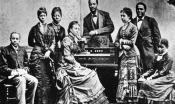When I reflect on the incidents last week involving students who wore offensive shirts with anti-Muslim statements on them in Gainesville, Florida, I cannot help but to think of Jonathan Swift’s quote, “We have just enough religion to make us hate, but not enough to make us love one another.” I don’t agree with Swift, though. All we have to do is observe how no local company in Gainesville, Florida would agree to print the T-shirts.

